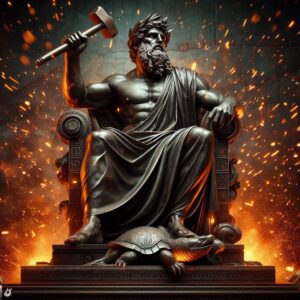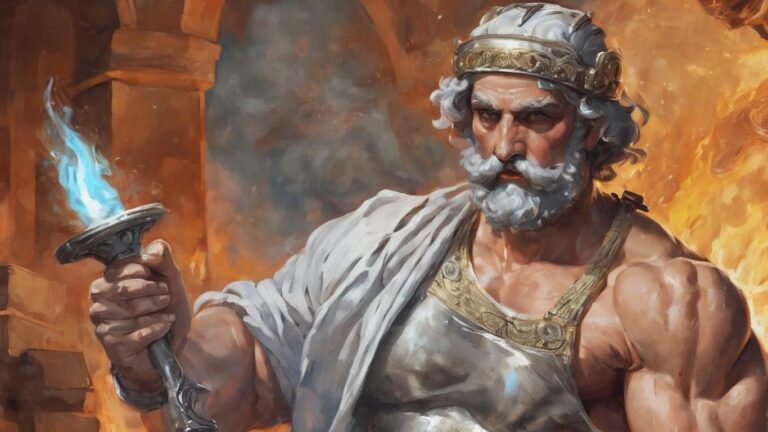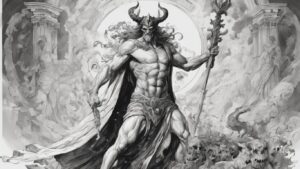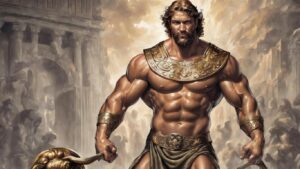Table of Contents
Hephaestus is a figure in Greek mythology and is known as the god of fire, metalworking, blacksmiths, craftsmen, and artisans. He is often associated with the forge and is considered one of the Twelve Olympian gods, the principal deities of the Greek pantheon. He is usually depicted as a skilled and talented blacksmith who crafted weapons, armor, and other objects for the gods and heroes.
Origin
Appearance

In the realm of Greek art and mythology, Hephaestus emerges as a bearded and somewhat disfigured deity. His physical impairment, often portrayed as a limp, signifies the notion that he either bore a disability from birth or acquired it after being expelled from Olympus. Despite this challenge, He is depicted as a potent and adept figure.
Transitioning to his attributes:
Firstly, the Forge and Anvil stand as prominent symbols in artistic representations of Hephaestus. Frequently adorned with a blacksmith’s hammer, tongs, and other tools, these images underscore his pivotal role as the god of metalworking and craftsmanship. Many depictions capture him engrossed in his craft at an anvil in his forge.
Secondly, the Lame Leg becomes a focal point in certain artistic renderings, emphasizing the mythological narrative surrounding his descent from Olympus.
Lastly, a Beard and Mature Appearance define Hephaestus in the artistic realm, highlighting his mature stature and bearded countenance, reinforcing his esteemed status among the Olympian deities.
It’s crucial to acknowledge that artistic interpretations can vary, and diverse representations of Hephaestus exist in ancient Greek and Roman art. The traits mentioned above, however, serve as recurrent themes associated with Hephaestus in classical art and literature.
Personality
Hephaestus is given various personality traits and characteristics through the myths and stories that feature him. While his personality can vary depending on the specific myth or narrative, some common attributes associated with Hephaestus include:
Skilled Craftsman. Renowned for exceptional blacksmithing, he is a diligent craftsman, creates ingenious, extraordinary objects for gods and heroes in various myths.
Resilient and Resourceful. Facing physical impairment and challenges, Hephaestus, a resilient deity, overcomes obstacles, showcasing determination and unwavering perseverance.
Cunning and Clever. Some myths depict Hephaestus demonstrating cunning and cleverness. For instance, he strategically sets a trap for Hera after Olympus banishment.
Emotional and Human-Like Feelings. Portrayed as a deity with emotions, he experiences anger, resentment, and compassion in certain myths. His relationships, especially with Hera and Aphrodite, reveal emotional depth.
It’s important to note that Greek mythology is rich with diverse stories, and different myths may emphasize different aspects of Hephaestus’ personality.
Myths

Hephaestus, the skilled craftsman of Olympus, sculpted Pandora from clay under Zeus’s command. Gods bestowed gifts upon her, and she, a bearer of punishment, carried a jar harboring the world’s evils. As she descended, humanity faced impending doom.
Transitioning to another tale, Hephaestus wove a net, cunningly trapping Aphrodite and Ares in an adulterous embrace. Exposing them to divine mockery, the duo faced the wrath of their peers.
During the Trojan War, Hephaestus forged Achilles‘ famed armor, renowned for its divine craftsmanship. Homer vividly detailed the hero’s shield, an emblem of Hephaestus’ unparalleled skill.
In a darker myth, Hephaestus played a role in Prometheus’ torment. Binding the Titan to a rock, the daily ritual of eagle-inflicted agony unfolded, orchestrated by the god of the forge.
Transitioning again, the gods witnessed Hephaestus’ strategic prowess as he ensnared Ares and Aphrodite in a golden net. Presenting the scandalous pair to their divine kin, the adulterers faced divine judgment.
A curious liaison emerged in the myth of Athena‘s birth. Hephaestus, driven by desire, sought Athena. Yet, she resisted, resulting in a peculiar birth—the seed on her thigh bore Erichthonius, whom Athena adopted as her own.
Lastly, in the tumult of the Gigantomachy, Hera faced captivity at the hands of Porphyry. Hephaestus, aided by Ares, intervened, rescuing the queen of the gods from the clutches of the Giant.





